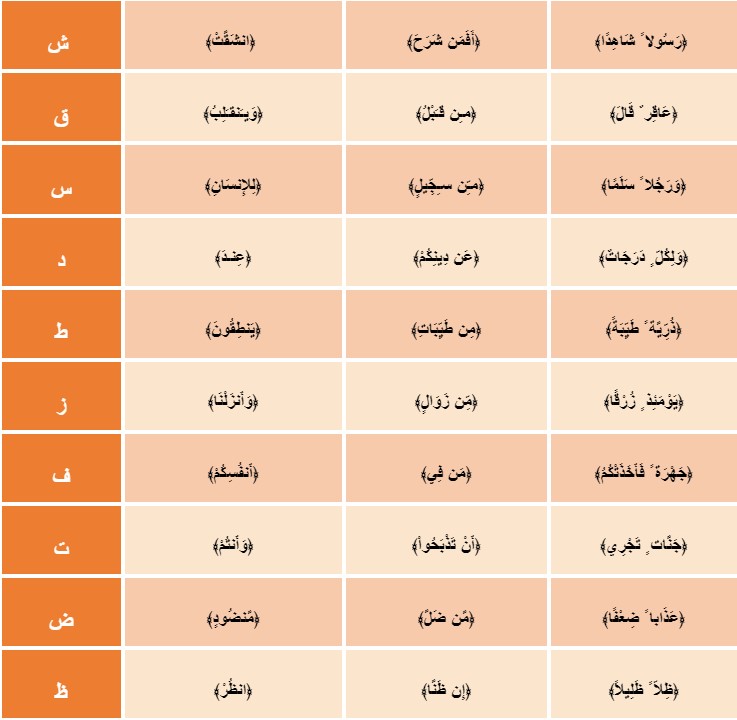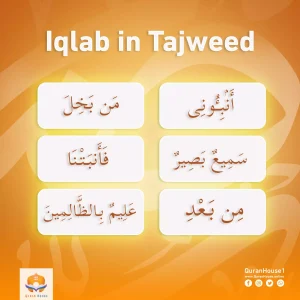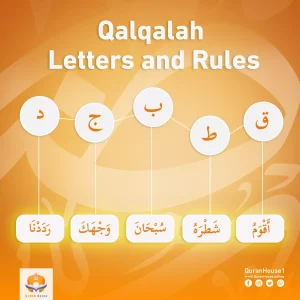Quran recitation is one of the most rewarding acts a Muslim can do. Narrated ‘Aisha: the Messenger of Allah(ﷺ) said: “The one who is proficient with the Quran will be with the noble and righteous scribes (the angels), and the one who reads it and stumbles over it, finding it difficult, will have a double reward.”
In this article, we will shed some light on one of the most important topics in tajweed, which is the rules of ikhfaa’ haqiqi.
What is Ikhfa?
The Arabic word ikhfaa linguistically means hiding or covering, and haqiqi means real or true.
Whereas in tajweed study, ikhfaa’ means the pronunciation of noon sakinah or tanween somewhere between izhaar and idghaam, retaining the ghunnah (a nasal sound) while concealing the noon behind the letter following it.
Enhance your learning experience by exploring Noorani Qaida, a fundamental tool for beginners in Quranic recitation. Join online classes with native Arab instructors to receive expert guidance and personalized attention.
How is Ikhfa letters are pronounced?
If you want to pronounce the rule of ikhfaa, you need to follow the following rules
- Correct pronunciation of ikhfaa’ is obtained by placing the tongue in a position of readiness to articulate the letter the following noon while holding the ghunnah for two counts.
- Avoid touching the upper part of the mouth with the tip of the tongue during the ghunnah or else noon will be evident and not hidden.
- Note that: the ghunnah of ikhfaa’ follows the letter that comes next as regards heaviness and lightness (i.e the ghunnah of Ikhfaa’ is heavy if it is followed by a heavy letter and vice versa).
What are Ikhfa letters?
Ikhfaa Haqiqi are specific Tajweed Letters that are counted as fifteen letters when comes after noon sakinah or tanween. If you find any of the following fifteen letters after noon sakinah or tanween, you should hide the noon and make a ghunnah of two counts length.
ت ث ج د ذ زس ش ص ض ط ظ ف ق ك
How to memorize Ikhfa letters?
Here are some tips and tricks that can help you memorize the letters of Ikhfaa’:
- The first way is to memorize the Ikhfaa’ letters separately, using the 3 sections of the fingers of one hand, which makes 15 letters.
ت ث ج د ذ زس ش ص ض ط ظ ف ق ك
- Another way is to study the following phrase, ikhfaa’ letters are found at the beginning of each of its words.
صِف ذا ثَنَا كَمْ جَادَ شَخْصٌ قَدْ سَمَا
دُمْ طَيِّبًا زِدْ في تُقًي ضَعْ ظَالِمًا
- Or simply by exclusion! Knowing that the letters of izhaar are (ء ، هـ ، ع ، ح ، غ ،خ ), idghaam letters are ( ي ، ر ، م ، ل ، و ، ن ) and iqlab letter is ( ب ) , the remaining 15 letters are the ikhfaa’ letters.
Ikhfaa Letters With Examples:
Here are some examples of the ikhfaa that would help you when practicing:


Discover the profound meanings behind the verses of the Quran with our comprehensive online Quran Tafseer course. Our expert instructors will guide you through the interpretation of the Quran, helping you understand the pure spirit of Islam.
What is the difference between ikhfaa’ haqiqi and ikhfaa’ shafawi?
The main difference between ikhfaa’ haqiqi and ikhfaa’ shafawi is the following
- Ikhfaa’ haqiqi refers to hiding the noon sakinah or tanween when they are followed by the fifteen letters of ikhfaa’.
- Whereas, ikhfaa’ shafawi means hiding the sound of Meem sakinah (م) with the retention of ghunnah in case it is followed by the letter Baa’ (ب) as in:
- تَرْمِيهِم بِحِجَارَةٍ
- وَهُم بِالْآخِرَةِ
It is called shafawi since the letters Meem and Baa’ share the same makhraj (i.e place of articulation) which is the lips.
How is ikhfaa’ written in the Quran?
You can easily spot ikhfaa’ in the Quran in one of the following forms:
- Noon with nothing above it and the letter that follows it has no shaddah ( ّ ) (Since the noon is not completely merged but only hidden).
- The double fathah, kasrah, and dhammah are not aligned over each other and are not directly over the letter, the letter next to it has no shaddah.
Why do we make ikhfaa’?
The cause of ikhfaa’ is that the makhraj (place of articulation) of the 15 letters of ikhfaa’ is neither close to (as idghaam) nor far (as izhaar) from the makhraj of noon. Therefore, we pronounce it somewhere between idghaam and izhaar.
Unlock the true beauty of Quranic recitation by enrolling in online Tajweed classes taught by native Arab instructors. Polish your recitation skills and receive valuable feedback to recite the Quran flawlessly.
What are the levels of ikhfaa’?
Ikhfaa’ haqiqi has three levels depending on the closeness of the makhraj of ikhfaa’ letters to the noon. This can be summarized as follows:
The highest level of ikhfaa’:
When noon sakinah or tanween are followed by (د ، ت ، ط ), in this case, ikhfaa’ is nearest to idghaam since the makhraj of these three letters is close to the makhraj of noon.
The lowest level of ikhfaa’:
The lowest level of ikhfaa happens when noon sakinah or tanween are followed by ( ق ، ك ) ikhfaa.’ It is the least, in this case, it is more similar to izhaar because the makhraj of these letters is furthermost from the noon.
The intermediate level of ikhfaa’:
It occurs with the other ten letters since their makhraj is neither far nor near from the makhraj of noon.
The duration it takes to learn Tajweed can vary greatly depending on several factors, including the learner’s dedication, consistency, and the complexity of the rules. For a more detailed discussion on this topic, refer to our article: How long does it take to learn Tajweed for beginners.
Common mistakes to avoid while making ikhfaa’:
- Emphasizing the sound of ghunnah which makes it sound more like idgham.
- Pronouncing the ghunnah with the incorrect duration (the correct duration of ghunnah is 2 harakah or 2 finger counts).
- Not differentiating between full mouth (heavy) and empty mouth (light) ikhfaa’ sound according to the letter that comes next.
Now test your knowledge!
Now that you have learned the rules of ikhfaa, it is time to put it into practice!
Spot out ikhfaa’ haqiqi from the following Quran verses:
بسم الله الرحمن الرحيم
وَبَشِّرِ الَّذِين آمَنُواْ وَعَمِلُواْ الصَّالِحَاتِ أَنَّ لَهُمْ جَنَّاتٍ تَجْرِي مِن تَحْتِهَا الأَنْهَارُ كُلَّمَا رُزِقُواْ مِنْهَا مِن ثَمَرَةٍ رِّزْقًا قَالُواْ هَذَا الَّذِي رُزِقْنَا مِن قَبْلُ وَأُتُواْ بِهِ مُتَشَابِهًا وَلَهُمْ فِيهَا أَزْوَاجٌ مُّطَهَّرَةٌ وَهُمْ فِيهَا خَالِدُونَ (سورة البقرة).
Give good news ˹O Prophet˺ to those who believe and do good that they will have Gardens under which rivers flow. Whenever provided with fruit, they will say, “This is what we were given before,” for they will be served fruit that looks similar ˹but tastes different˺. They will have pure spouses,1 and they will be there forever.
Surah al-Baqarah 2:25
Click here to send us your answer and see the results
Need more practice?
Tajweed learning For Kids requires a lot of practice. Therefore, besides learning the theoretical aspect of tajweed, it is advisable to get your recitation corrected by a professional teacher. Quran House is here to help you learn tajweed online through live one-to-one sessions conducted by highly qualified tutors.
Understanding Tafkheem and Tarqeeq, the concepts of ‘heaviness’ and ‘lightness’ in Arabic letters, is crucial for correct Quran recitation. For a detailed guide on these concepts, check out this article on Heavy and Light Letters https://quranhouse.online/heavy-and-light-letters-tafkheem-and-tarqeeq/Tafkheem and Tarqeeq.
References:
- An Introduction to Tajweed/Umm Muhammad Jeddah, 2015, DAR ABUL-QASIM, 2015 2nd edition, in print since 1993.
- Tajweed rules of the Quran, Part One, By Kareema Carol Czerepinski, Introduction written by his eminence Ash-Sheikh Dr. Ayman Rushdi Swayd.






